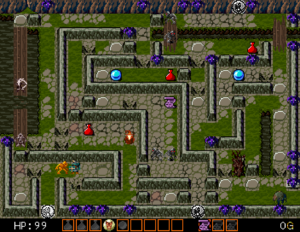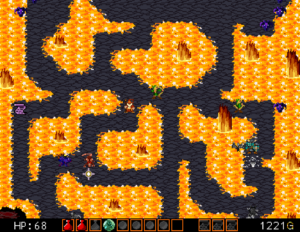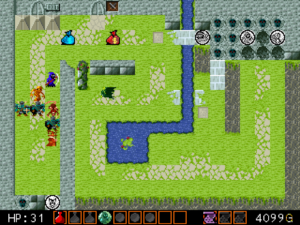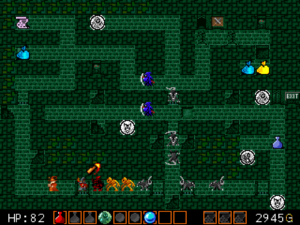Official Site || Steam Page || Humble Store Page
The Soulcaster games are part tower defense and part Gauntlet without quite being either. Though MagicalTimeBean is better known for Escape Goat these days, the XBLIG launch of Soulcaster is what first put them on the map. With the PC bundle of the first two games in the series recently coming out on Steam and the third game scheduled to release next year, this is the perfect time to take a look at what makes these unusual games so great.
These games are virtually identical other than the maps themselves and a few new enemies and graphical additions in the second game. In both games you take on the silent role of the titular Soulcaster as he combats the undead legions of Shadowcaster with the help of the spirits of Shaedu the archer, Aeox the warrior, and Bloodfire the alchemist; the plot is paper-thin and largely inconsequential. The Soulcaster has no direct attack, though he can use a Scroll of Ruin to heavily damage every enemy near him, and if he completely runs out of life you need to restart the stage, but this is where Soul Orbs come into play. Other than at the very start of the game the Soulcaster has access to three Soul Orbs and can permanently purchase up to two more from the shop. Each of the Soulcaster’s allies has a specific button assigned to them and pressing that button will expend a Soul Orb to summon a copy of them to the Soulcaster’s current tile. You can have multiple copies of the same ally on the field at once and you can press a ‘recall’ button to turn the oldest summon back into a Soul Orb.

Learning how best to make use of each ally’s strengths while mitigating their weaknesses is the key to the gameplay. Aeox is the only one of the three who can take more than one or two hits, but he can only hit enemies directly next to him and his defense boost is negated if he becomes attacked by enemies from two or more sides at once. Shaedu can deal high damage very quickly, but they need line of sight and can’t shoot arrows through allies. Lastly, Bloodfire can toss capsules over walls and allies which explode to deal damage in an area, but he can’t affect flying enemies if they aren’t over solid ground, his damage is lower than Shaedu’s, and he causes a large explosion upon dying which damages enemies, other allies (which can cause a chain reaction if there are multiple copies of Bloodfire near each other), and even the Soulcaster. Each character also has an enemy which counters them; golden zombies are completely immune to Bloodfire’s attack, white grim reapers dodge 50% of Shaedu’s attacks, and in the second game scorpion rats can safely attack Aeox from outside of his reach.
The recall and merchant mechanics have a few noteworthy traits to them. A merchant shop is present on most stages, though it may be hidden or not immediately available. Buying upgrades and items at the merchant is the only way to get stronger and upgrades to damage, attack speed, and attack range are available for Shaedu and Bloodfire while Aeox gets a health upgrade instead of a range increase due to being limited to melee combat. Each upgrade has five ranks and getting every upgrade for a character to the maximum level unlocks a special bonus upgrade for them. Scrolls of Ruin and health potions, which fully refill the Soulcaster’s health if he would otherwise die, can also be purchased at the merchant as well as two all-important Soul Orbs. You can carry three health potions and three Scrolls of Ruin at any given time and it is entirely possible to stand around buying and using the scrolls outside of a shop, but money management is an important factor here. There’s no backtracking and enemies give a small amount of money upon being killed and also sometimes drop bags worth various amounts of gold, so spending money on potions and scrolls will cut into your limited supply of cash and make the game much harder down the road.

As to the recall mechanic, it’s vital for far more than just fixing mistakes and knowing when to recall allies is every bit as important as placing them. If an ally is recalled their Soul Orb can immediately be reused, but allies who die in combat turn into a swirl of grey energy for several seconds before returning to you, potentially leaving you completely defenseless if they all get wiped out at once. One dividing factor about the recall system is you can’t see the health of your allies. At first, I found the lack of healthbars annoying as it made it difficult to tell just when the best time to recall actually was. However, this design choice gradually won me over; Shaedu and Bloodfire are so fragile that they die in one or two hits from just about anything, making healthbars unnecessary for them, and the lack of a health indicator for Aeox creates a pleasant sense of risk versus reward as you become more skilled at judging his health. In a similar fashion, the limited order in which you can recall adds an additional layer of strategy and pressure. Do you recall the old, well-placed copy of Aeox so you can recall a newer copy of Shaedu who is at risk of dying? Do you have risk taking the time to readjust the positions of all of your allies because you just summoned a copy of Bloodfire in a spot where he might cause a chain reaction if he gets hit? Enemies constantly pour in from every direction and you constantly need to move, recall, and resummons your allies with few, if any, breaks in the action.
Though placing stationary units is the primary method of both offense and defense, the actual structure of each stage learns far closer to Gauntlet than to a standard tower defense. Sure, there are a handful of stages designed so that enemies walk down lanes while you stay in a specific area (though you don’t have to), but in the vast majority of cases you are constantly moving from one makeshift safe haven to the next. Part of this is due to the way in which enemy spawners appear; stepping on a switch or killing most of the current enemies or even just walking into a certain part of the map can trigger an entire new set of spawners to pop into existence. Each spawner is marked by a symbol to indicate which enemies are attached to it, spawners shatter once all of their linked enemies are killed, and some spawners you can even predict in advance if you pay close attention to your surroundings; statues, cracks on the walls, locked doors, and more are all likely to suddenly transform into a glowing gem spewing forth enemies at some point.

The way the environment shifts in general is really what gives the Soulcaster games its unique feel. You may think you have set up a great defense in a small corner, but the dead end behind you might suddenly explode to reveal a bunch of spawners, trapping you between the existing enemies, a new wave of foes, and your own allies. If you find a spot which seems too good to be true, it almost certainly is, and not just from the danger of new enemies appearing; walls frequently collapse after killing enough enemies and you need to learn to move whenever the opportunity presents itself; a small house with a single-tile entrance where you can easily defend yourself by placing multiple alchemists behind a single warrior can turn into a deathtrap in the blink of an eye when the walls collapse and you are left exposed with enemies in every direction. Stepping on a switch may open the path forward while simultaneously creating a bridge across a gap so enemies can reach you much faster. The floor may collapse after you walk across it or a suspicious switch placed on the same tile as a valuable Scroll of Ruin may spawn a black grim reaper which can even cut through Aeox’s defenses in a handful of hits. There is little value in carefully studying your surroundings because they will inevitably change in unexpected ways. I am not at all saying that Soulcaster feels unfair, but it will more than happily punish players again and again for being unwilling to readjust their strategies on the fly.
Despite both games using the same engine and mechanics, the sequel is easily the superior entry. Slightly more content, bigger maps in general, a few graphical boosts, and a better soundtrack (though the first game’s soundtrack is still great) all add up to give the sequel a noticeable edge over its predecessor. However, there are also more significant changes present as well. There are only a handful of new enemy types, but the scorpion rats which can attack Aeox from range and mimics, shadow versions of your character which shoot spells and only move when you move, change things up substantially. Most importantly, the map design is simply much better. Shaedu the archer feels virtually worthless in most of the maps in the first entry as corridors are frequently carved out of stone walls or other things which Shaedu can’t shoot through. On the other hand, most of the ‘barriers’ in the second game come in the form of pits, lava, water, or other ground-based obstacles which arrows can shoot across and which bats can fly over to render Bloodfire’s attacks useless. Maps also get more creative in the sequel, such as a stage where you need to navigate a shifting maze without killing enemies because doing so causes a swarm of much more dangerous creatures to appear or another stage where you can flip a switch to divert the water in a river and potentially trap numerous enemies inside the newly-formed lake to render them helpless.

The one slight downside to this series is just how short the games are as each game can easily be finished in about two hours or less. There are several challenge mode stages to try out where the goal is to open and reach the exit as quickly as possible, but these also will only take up about an hour of your time. This brevity is somewhat countered by the sense of replayability gained by the fact that going through the games with different character upgrades can result in substantially different experiences and completing the default difficulty unlocks Hard Mode, though I did not notice any significant changes brought about by this higher difficulty. Despite their short durations, the Soulcaster games are ultimately still very entertaining and remarkably unique, making them well worth purchasing.